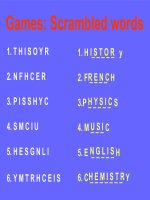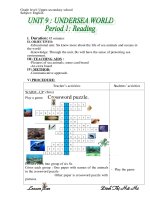Reading Assessment
Bạn đang xem bản rút gọn của tài liệu. Xem và tải ngay bản đầy đủ của tài liệu tại đây (208.73 KB, 52 trang )
1
Reading Assessment
Helen Huntley
Senior English Language Fellow
MOET, Vietnam
2
Workshop Goals
To examine the micro- and macro-skills of reading
comprehension
To look at the different characteristics of intensive
reading
To review strategies for intensive reading
To examine some problem areas in reading
To discuss different types of reading assessments
To evaluate test items for reading
To practice creating test items for reading
3
Types of Written Texts
Academic Reading
Reference material (dictionaries etc.)
Technical reports (lab reports, journal articles)
Articles in magazines and newspapers
Textbooks, theses
Essays, papers
Test directions, test content
Curriculum/syllabus documents
Editorials, opinion writing
Internet research
4
Types of Written Texts
Job-related reading
Messages (phone messages, memos)
Letters/emails
Reports (job evaluations, project reports)
Schedules, signs, labels, announcements,
advertisements
Forms, applications, questionnaires
Financial documents (bills, invoices)
Directories (telephone, office)
Manuals, instructions
5
Types of Written Texts
Personal reading
Newspapers, magazines
Letters, emails, greeting cards, invitations
Messages, notes, lists
Schedules (buses, flights, trains)
Recipes, menus, maps, calendars
Advertisements
Fiction (novels, short stories, drama, poetry)
Financial documents (tax forms, loan applications)
Comic strips, cartoons, jokes
Journals, diaries
Internet information
6
Microskills for Reading
Comprehension
Recognition of letters, words, and spelling
Ability to retain ‘chunks’ of language in short-term
memory
Ability to process written text at an efficient speed
Processing of vocabulary and grammatical patterns
Differentiation of word classes (noun, verb etc.)
Recognition of alternate meanings and grammatical
forms
Recognition and utilization of textual cohesive devices
which indicate relationships between ideas
7
Macroskills for Reading
Comprehension
Recognition of rhetorical forms of written discourse
Recognition of the purpose and communicative function of
a text
Making inferences by using background knowledge
Inferring connections and relationships within a text
Distinction of literal from implied meanings
Appropriate interpretation of cultural references
Use of reading strategies to extract meaning from text
skimming, scanning, guessing, activating background knowledge,
detecting discourse markers
8
Characteristics of Intensive Reading
Emphasis on the quality of reading
Short texts
Difficult texts (i + 1)
Usually authentic texts
Many tasks to complete after reading
Reading is slow and careful
Need to understand the text in detail
Primarily for language study/testing and reading skills’
development
Teacher/test-driven
Teacher/tester selects texts
(Teacher often intervenes in the reading process)
Teacher/tester determines where and when to read
Reading is usually done in the classroom/test situation
Davidson, P. (2005). Facilitating language learners’ vocabulary development through extensive reading. Assoc. of Teachers of English in
Lebanon Journal, 14: 19-25.
9
Strategies for Intensive Reading
Comprehension I
Preview and make predictions
Identify the author’s purpose and argument
Use graphemic rules and patterns to aid in bottom-up
decoding
Use efficient silent reading techniques for relatively
rapid comprehension
Skim the text for main idea
Scan the text for specific information
Use semantic mapping or clustering
Guess when uncertain (vocabulary, inference,
discourse relationship)
Analyze vocabulary: word part, roots, context
10
Strategies for Intensive Reading
Comprehension II
Distinguish between literal and implied meanings, fact
and opinion
Capitalize on discourse markers to process
relationships and organization
Draw inferences from both stated and implied content
Identify pronoun references
Understand the components of nonlinear texts
(graphs, charts, diagrams)
Sequencing of ‘events’
Insertion of ‘missing’ sentences into a text
Identify the components of a text summary
11
Some Problem Areas…..
Bottom-up and top-down processing
Activation of prior knowledge
Utilization of pre-reading activities
Vocabulary development
Guessing Strategies
Reading Rate
Assessment of reading
12
Bottom-up and Top-down
Processing
“Research has shown that reading is only
incidentally visual. More information is
contributed by the reader than by the
print on the page. That is, readers
understand what they read because they
are able to take the stimulus beyond its
graphic representation and assign it
membership to an appropriate group of
concepts already stored in their
memories… Skill in reading depends on
the efficient interaction between linguistic
knowledge and knowledge of the world”
Clarke, M. & Silberstein, S. (1977). Toward a realization of psycholinguistic principles for the ESL
reading class. Language Learning 27: 135-54.
13
Activating Prior Knowledge
(schema/schemata)?
Facilitates comprehension
Unlocks vocabulary before reading
Makes readers more independent
14
Activating Prior Knowledge?
From Sayers, D.(1967) Murder must advertise
The innings opened briskly. Mr. Barrow, who
was rather a showy hat, though
temperamental, took the bowling at the
factory end of the pitch and cheered the
spirits of his side by producing twos in the
first over. Mr. Garrett, canny and cautious,
stonewalled perseveringly through five balls
of the following over and then cut the
leather through slips for a useful three.
15
What do we know?
David knew that his son’s operation
would be expensive. There was
always Aunt Martha. David reached
for the telephone book.
16
What don’t we know?
Annie heard the ice cream man
coming down the street. She
remembered her Christmas money
and ran into the house. She locked
the door…
17
Activating Activities
Pre-reading discussion
Semantic maps
Visuals: pictures, photographs, charts
Expectations of rhetorical patterns
Predictions/hypotheses
18
The Role of Vocabulary in
Reading
Research Studies
Levine & Reeves (1990) cite “lack of adequate vocabulary…
as one of the obstacles to text comprehension” and point
out that “frequent and numerous recycling should be…
emphasized”
Grabe (1991) cites the important role of vocabulary as a
predictor of overall reading ability
Nation (1990) emphasizes “ a systematic and principled
approach to vocabulary by both the teacher and the
learners”
Learning vocabulary is important for reading!
Focus on most frequent words.
19
Extensive Reading = Extensive
Vocabulary
Anderson (1996): the average 12
th
grader knows
about 80,000 words in L1; children learn up to
4,000-6,000 new words each year
Miller (1977): children between 6-8 pick up an
average of 14 new words a day
Nagy & Herman (1987): children acquire 3,000
words per year between grades 3-12
20
Five-Step Guessing Strategy
How successful is guessing?
1. Look at the unknown word and decide
its part of speech.
2. Look at the context (clause, sentence)
What word goes with what?
3. Look at the relationship with other
sentences. Are there signal words?
4. Guess the word.
5. Check that the guess is correct.
21
Increasing Reading Rate
“… fluent reading is rapid; the reader
needs to maintain the flow of
information at a sufficient rate to
make connections and inferences
vital to comprehension”
Grabe (1991). Current developments in second language reading research. TESOL Quarterly 25: 375-406
22
L1 Reading Rates
Carver, R. P. (1990).
Reading rate: A review of research and theory
. Academic
Press.
Reading
Process
Processing
Components
Target Words
Per Minute
Scanning Lexical accessing
600
Skimming Semantic encoding
450
“Rauding” Sentence
integrating
300
Learning Idea remembering
200
Memorizing Fact rehearsing
138
23
Reading Rate Goal
At the intermediate level:
200 words per minute
+ 70% comprehension
24
Slow Reader Problems
These activities slow down reading:
Pronouncing every word while reading
Moving the lips while reading silently
Using a finger or pen to follow the words
Translating
Reading each word individually instead of in
chunks
Looking up all or some unknown words
25
Reading Assessment
A reading log of material read
Reading rate chart
Reading portfolio
Reading reports/journals
Oral reports
Comprehension questions in a variety of
formats
Quizzes/tests









